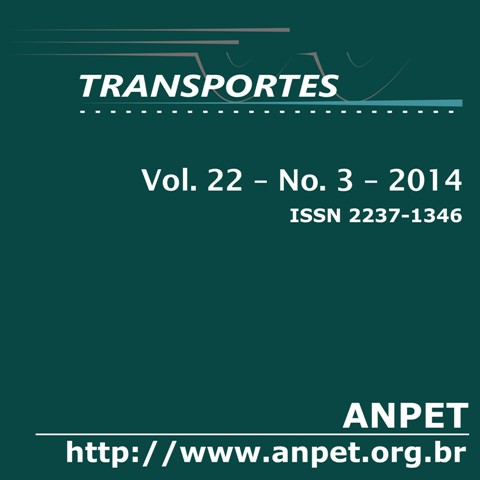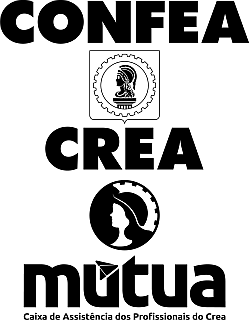Métodos de identificação de zonas de acumulação de acidentes: Revisão e aplicação a um caso de estudo
DOI:
https://doi.org/10.14295/transportes.v22i3.813Palavras-chave:
Highway Safety Manual. Segurança viária. Zonas de acumulação de acidentes. Medidas de desempenho. InterseçõesResumo
Neste trabalho apresenta-se uma descrição e análise resumida bem como a aplicação dos vários métodos de identificação de zonas de acumulação de acidentes propostos pelo manual Highway Safety Manual (HSM). É reconhecido internacionalmente a importância deste manual e a sua utilização pelos profissionais responsáveis da segurança viária. O HSM propõe e descreve 13 métodos para identificação de zonas de acumulação de acidentes, todos muito distintos quer em termos de âmbito de aplicação quer na complexidade dos mesmos. Com o objetivo de simplificar a escolha e aplicação destes métodos, o presente estudo descreve e organiza os diferentes métodos segundo 3 critérios que podem ser decisivos na escolha e aplicação dos métodos. Para além dos 13 métodos do HSM, apresenta-se ainda um método desenvolvido recentemente e designado de modelo binário probit. Para analisar os referidos métodos, considerou-se como caso de estudo a cidade do Porto, Portugal. Considerando este caso de estudo, foi possível analisar as dificuldades e especificidades de cada método, tendo-se verificado que nem todos os métodos foram possíveis de se aplicar. Os resultados da aplicação dos métodos foram analisados e comparados com base em testes de avaliação de desempenho. Os testes indicam que os métodos excesso previsto da frequência média de acidentes proposto pelo referido manual e o modelo binário probit, mais recentemente desenvolvido, apresentam os melhores resultados. Os resultados desta aplicação poderão servir de base para futuras aplicações noutras regiões e/ou países
Downloads
Referências
AASHTO (2010) Highway Safety Manual. American Association of State Highway and Transportation Officials, Washington DC. ISBN: 978-1-56051-477-0
Bandyopadhyaya, R. e Mitra, S. (2011) Comparative Analysis of Hotspot Identification Methods in the Pres-ence of Limited Information. 3rd International Conference on Road Safety and Simulation Transportation Research Board, Indianapolis, USA.
Cafiso, S. e Silvestro, G. D. (2011) Performance of Safety Indicators in Identification of Black Spots on Two-Lane Rural Roads Transportation Research Record: Journal of the Transportation Research Board, 2237, 78-87. DOI: 10.3141/2237-09
Chen, Y., Persaud, B. e Sacchi, E. (2012) Improving Transferability of Safety Performance Functions by Bayesian Model Averaging. Transportation Research Record: Journal of the Transportation Research Board, 2280, 162-172. DOI: 10.3141/2280-18
Cheng, W. e Washington, S. (2008) New Criteria for Evaluating Methods of Identifying Hot Spots. Transporta-tion Research Record: Journal of the Transportation Research Board, 2083, 76-85. DOI: 10.3141/2083-09
Coll, B., Moutari, S. e Marshall, A. H. (2013) Hotspots identification and ranking for road safety improvement: An alternative approach. Accident Analysis & Prevention, 59, 604-617. DOI: 10.1016/j.aap.2013.07.012
Couto, A. e Ferreira, S. (2013) Método Probabilístico para Identificação de Zonas de Acumulação de Acidentes. Confederação Nacional do Transporte, Brasilia, Brasil. ISBN - 978-85-99082-18-8
Elvik, R. (2008) Comparative Analysis of Techniques for Identifying Locations of Hazardous Roads. Transportation Research Record: Journal of the Transportation Research Board, 2083, 72-75. DOI: 10.3141/2083-08
Ferreira, S. e Couto, A. (2012) A Probabilistic Methodolo-gy for Hot Spot Identification. TRB 2012 Annual Meeting, Transportation Research Board, Washington DC, USA, 16 pages.
Ferreira, S. e Couto, A. (2013) Hot-spot Identification: a Categorical Binary Model Approach. Transportation Research Record: Journal of the Transportation Research Board, 2386, 1-6. DOI: 10.3141/2386-01
Geedipally, S. R. e Lord, D. (2010) Identifying Hot Spots by Modeling Single-Vehicle and Multivehicle Crashes Separately Transportation Research Record: Journal of the Transportation Research Board, 2147, 97-104. DOI: 10.3141/2147-12
Geurts, K., Wets, G., Brijs, T. e Vanhoof, K. (2004) Identi-fication and Ranking of Blackspots: Sensitivity Analysis Transportation Research Record: Journal of the Transportation Research Board, 1897, 34-42. DOI: 10.3141/1897-05
Hauer, E., Allery, B., Kononov, J. e Griffith, M. (2004) How best to rank sites with promise. Transportation Research
Record: Journal of the Transportation Research Board, 1897, 48-54. DOI:10.3141/1897-07
Kononov, J. (2002) Identifying Locations with Potential for Accident Reductions: Use of Direct Diagnostics and Pattern Recognition Methodologies. Transportation Research Record: Journal of the Transportation Research Board, 1784, 153-158. DOI: 10.3141/1784-19
Lan, B. e Persaud, B. (2011) Fully Bayesian Approach to Investigate and Evaluate Ranking Criteria for BlackSpot Identification. Transportation Research Record: Journal of the Transportation Research Board, 2237, 117-125. DOI: 10.3141/2237-13
Martins, J. C. (2013) Seleção de Interseções com Poten-cial de Redução da Sinistralidade - Aplicação do HSM. Master degree, Universidade do Porto.
Montella, A. (2010) A comparative analysis of hotspot identification methods. Accident Analysis and Prevention, 42, 571-581. DOI: 10.1016/j.aap.2009.09.025
Persaud, B., Lord, D. e Palminaso, J. (2002) Calibration and Transferability in developing accident prediction models for urban intersections. Transportation Research Record: Journal of the Transportation Research Board, 1784, 57-64. DOI: 10.3141/1784-08
Sacchi, E., Persaud, B. e Bassani, M. (2012) Assessing International Transferability of Highway Safety Manual Crash Prediction Algorithm and Its Components Trans-portation Research Record: Journal of the Transportation Research Board, 2279, 90-98. DOI: 10.3141/2279-11
Sawalha, Z. e Sayed, T. (2006) Transferability of accident prediction models. Safety Science, 44, 209-219. DOI: 10.1016/j.ssci.2005.09.001
Downloads
Publicado
Como Citar
Edição
Seção
Licença
Ao submeter um manuscrito para publicação neste periódico, todos os seus autores concordam, antecipada e irrestritamente, com os seguintes termos:
- Os autores mantém os direitos autorais e concedem à Transportes o direito de primeira publicação do manuscrito, sem nenhum ônus financeiro, e abrem mão de qualquer outra remuneração pela sua publicação pela ANPET.
- Ao ser publicado pela Transportes, o manuscrito fica automaticamente licenciado sob a Licença Creative Commons CC BY 4.0. Esta licença permite o seu compartilhamento com reconhecimento da autoria e da publicação inicial neste periódico.
- Os autores têm autorização para assumir contratos adicionais separadamente, para distribuição não exclusiva da versão do trabalho publicada neste periódico (por ex.: publicar em repositório institucional ou como capítulo de livro), com reconhecimento da publicação inicial na Transportes, desde que tal contrato não implique num endosso do conteúdo do manuscrito ou do novo veículo pela ANPET.
- Os autores têm permissão e são estimulados a publicar e distribuir seu manuscrito online (por ex.: em repositórios institucionais ou na sua página pessoal) depois de concluído o processo editorial. Como a Transportes é de acesso livre, os autores são estimulados a usar links para o DOI do artigo nesses casos.
- Os autores garantem que obtiveram todas as permissões necessárias dos empregadores para a publicação e o licenciamento CC BY 4.0 do manuscrito, especialmente se o empregador possuir alguma reivindicação sobre os direitos autorais do manuscrito. Os autores assumem total responsabilidade por questões de direitos autorais relacionadas ao empregador, isentando a ANPET e a Transportes de qualquer responsabilidade relacionada.
- Os autores assumem toda responsabilidade sobre o conteúdo do manuscrito, incluindo as devidas e necessárias autorizações para divulgação de dados coletados e resultados obtidos, isentando a ANPET e a Transportes de toda e qualquer responsabilidade neste sentido.
Última atualização: 27/11/2025











